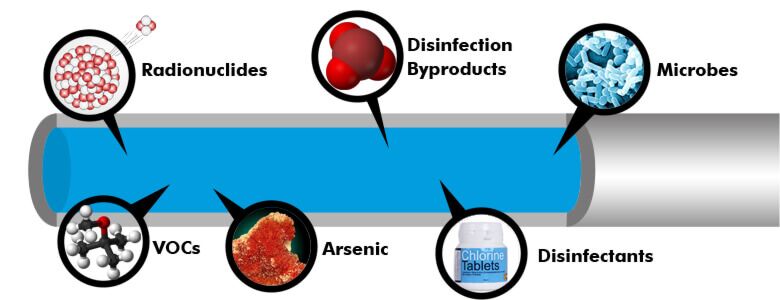
Most Common Water Contaminants Index Page
Drinking water, including bottled and tap water, may reasonably be expected to contain at least small amounts of some contaminants. In the United States, the EPA (Environmental Protection Agency) sets strict standards for approximately 90 different types of contaminants that can be found in drinking water. On this page, we have compiled a list of the most common water pollutants and categorized them below to provide you with detailed information on specific contaminants and their effects on your health.
Microbes ~ Radionuclides ~ Inorganics ~ Volatile Organics ~ Disinfectants ~ Disinfection Byproducts ~ MTBE
Disinfectants
Many water suppliers add a disinfectant to drinking water to kill germs such as giardia and e coli. Especially after heavy rainstorms, your water system may add more disinfectant to guarantee that these germs are killed.
Chlorine Some people who use drinking water containing chlorine in excess of EPA's standard could experience irritating effects to their eyes and nose as well as stomach discomfort.
Chloramines are most commonly formed when chlorine and ammonia are added together to treat drinking water. Water that contains chloramines is usually safe as long as it meets EPA regulations. However, some people who are exposed to chloramines in excess of EPA's standard may experience irritating effects to their eyes, nose and stomach.
Chlorine Dioxide is a water additive used to control taste and odor in water. Some infants and young children who drink water containing chlorine dioxide in excess of EPA's standard could experience nervous system effects as well as anemia. Similar effects may occur in fetuses of pregnant women who drink water containing chlorine dioxide in excess of EPA's standard.
Disinfection Byproducts
Disinfection byproducts form when disinfectants added to drinking water to kill germs react with naturally-occuring organic matter in water.
Total Trihalomethanes. Some people who drink water containing trihalomethanes in excess of EPA's standard over many years may experience problems with their liver, kidneys, or central nervous systems, and may have an increased risk of getting cancer.
Haloacetic Acids. Some people who drink water containing haloacetic acids in excess of EPA's standard over many years may have an increased risk of getting cancer.
Bromate. Some people who drink water containing bromate in excess of EPA's standard over many years may have an increased risk of getting cancer.
Chlorite. Some infants and young children who drink water containing chlorite in excess of EPA's standard could experience nervous system effects as well as anemia. Similar effects may occur in fetuses of pregnant women who drink water containing chlorite in excess of EPA's standard.
MTBE
MTBE is a fuel additive, commonly used in the United States to reduce carbon monoxide and ozone levels caused by auto emissions. Due to its widespread use, reports of MTBE detections in the nation's ground and surface water supplies are increasing. The Office of Water and other EPA offices are working with a panel of leading experts to focus on issues posed by the continued use of MTBE and other oxygenates in gasoline. EPA is currently studying the implications of setting a drinking water standard for MTBE.Drinking water, including bottled water, may reasonably be expected to contain at least small amounts of some contaminants.
Read Next: Health Risks of Heavy Metals


